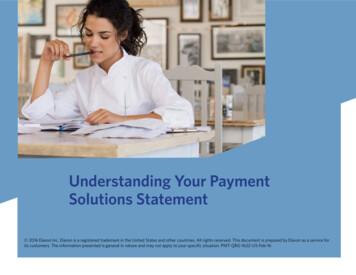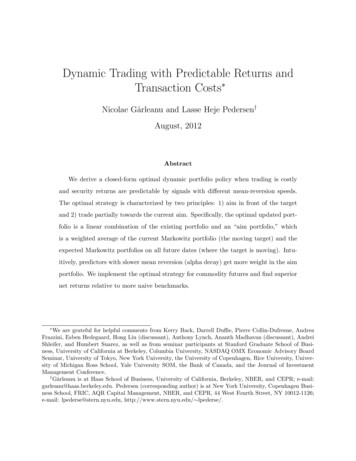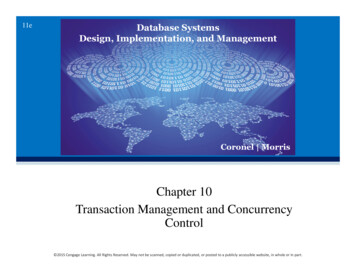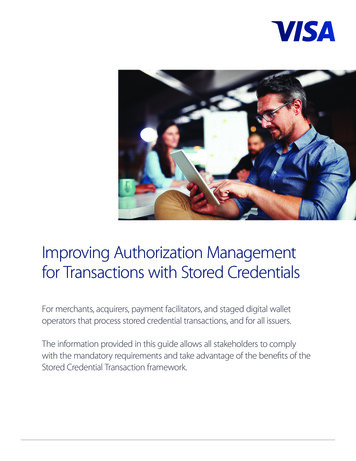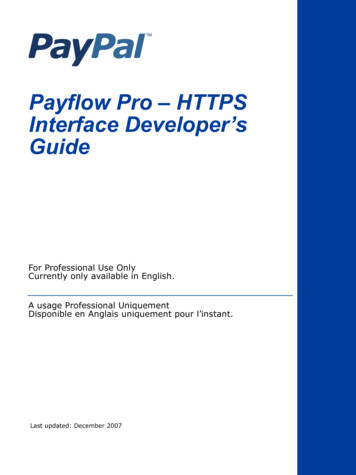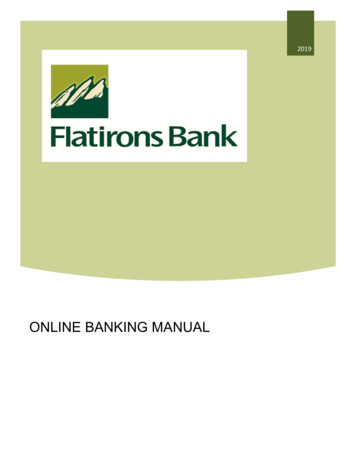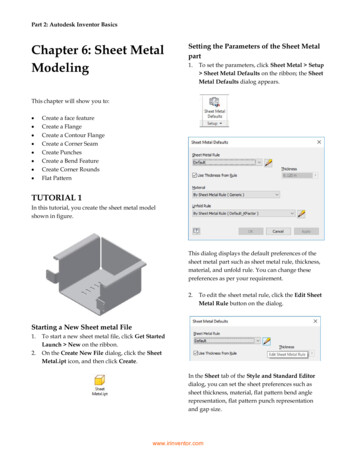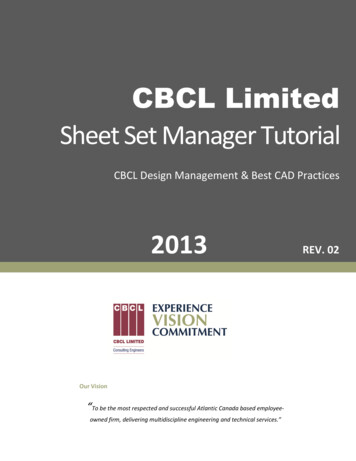
Transcription
TheTransactionAnalysisSheet
The Transaction Analysis SheetThe goal of this section is to learn how varioustransactions can affect and change the financialposition of a company.One of the ways that transactions can beexamined is by using a “Transaction AnalysisSheet”.It is vital that you remember the fundamentalaccounting equation:A L OE (Assets Liabilities Owner’s Equity)when completing the Transaction Analysis Sheet.
The Transaction Analysis SheetFirst let’s look at a simplified Balance Sheet for ABC Bike Cabs. TheBalance sheet is needed to gain the beginning balances for each account.
The Transaction Analysis Sheet As transactions occur, the balances of some or all of the accounts inthe Balance Sheet can be affected. A transaction analysis sheet should be used when studying andrecording changes in a business’s financial position. This sheet is builtin the same way as the fundamental accounting equation.A L OE
The Transaction Analysis SheetHere are some transactions that affect the financial position of ABC Bike Cabs:Transaction 1:ABC Bike Cabs pays 100 cash to Joe’s Bike Repair (creditor). The amounts for Cash and Accounts Payable are updated: Cash is decreased by 100. Debt owed to Joe’s Bike Repair is decreased by 100. The amounts for the other items remain unchanged.After the changes are recorded and the new totals determined,the equation is still in balance. This is very important!
The Transaction Analysis SheetTransaction Analysis Sheet after Transaction 1:
The Transaction Analysis SheetTransaction 2:The Belair Hotel, who owes ABC Bike Cabs 50.00, pays 25.00 inpartial payment of its debt. Cash is increased by the amount received: 25.00. Accounts Receivable - Belair Hotel is decreased by 25.00 but 25.00 is still owing on the debt.After the changes are recorded, the equation is still in balance.
The Transaction Analysis SheetAfter Transaction 2, the Transaction Analysis Sheet will look as follows:
The Transaction Analysis SheetTransaction 3:Additional safety equipment costing 200.00 is purchased for cash. Cash is decreased by the amount paid, 200.00. Equipment is increased 200.00.After the changes are recorded, the equation is still in balance.
The Transaction Analysis SheetAfter Transaction 3, the Transaction Analysis Sheet will look as follows:
The Transaction Analysis SheetTransaction 4:A new bike cab is purchased at a cost of 1000.00. ABC Bike Cabspays 200.00 cash and arranges a loan from Bank of Mom to coverthe balance of the purchase price. Cash is decreased by the amount paid: 200.00. Bike Cabs is increased by the cost of the new cab: 1,000.00. The liability to Bank of Mom is increased by the additional amountborrowed, 800.00.After the changes are recorded, the equation is still in balance.
The Transaction Analysis SheetAfter Transaction 4, the Transaction Analysis Sheet will look as follows:
The Transaction Analysis SheetTransaction 5:ABC Cabs has an extremely busy day when a cruise ship stops atthe town dock. The two cabs earned 2500.00 in fees for the day.Most clients paid cash for cab rides to the downtown shoppingdistrict. Some customers, however, bought a package deal from BigBear Marina for a meal and bike cab tour. Big Bear Marina will paythose fees (totaling 900.00) within 30 days. Cash is increased by 1600.00 Big Bear Marina owes 900 more to ABC Bike Cabs and thereforethe accounts receivable figure for Big Bear Marina is increased by 900.00. No other asset or liability is affected. Jon King’s capital is increased by 2500.00.After the changes are recorded, the equation is still in balance.
The Transaction Analysis SheetAfter Transaction 5, the Transaction Analysis Sheet will look as follows:
The Transaction Analysis SheetTransaction 6:Jon King, the owner, withdraws 1000 for personal use. Cash is decreased by 1000, the amount withdrawn. No other asset or liability is affected. Jon King, Capital is decreased by 1 000.After the changes are recorded, the equation is still in balance.
The Transaction Analysis SheetAfter Transaction 6, the Transaction Analysis Sheet will look as follows:
A New Balance SheetOnce all of the transactions have been completed, the Balance Sheetcan then be updated using the balances at the end of theTransaction Analysis Sheet.
The Transaction Analysis SheetYou will notice that there is a “Zero Proof” column at the end of the table.This column is used to ensure that the accounting equation stays in balanceafter each transaction. Remember the fundamental accounting equation:Assets Liabilities Owner’s Equity. A L OE If you move the L and OE tothe other side of the equation, you would get A – L – OE 0. In other wordswhen you subtract the liabilities and owner’s equity from the assets you getZERO – which “proves” your transactions are balanced.The Zero Proof columnuses this equationA-L-OE 0to verify that transactionsare balanced.Study the formula for ZeroProof in cell AD8 to seehow to enter the function.Add the Assets, subtractthe Liabilities & Owner’sEquity.The formula for Zero Proof in cell AD8 is SUM(U8:Y8)-SUM(Z8:AB8)-AC8
The Transaction Analysis Sheet As transactions occur, the balances of some or all of the accounts in the Balance Sheet can be affected. A transaction analysis sheet should be used when studying and recording changes in a business's financial position. This sheet is built in the same way as the fundamental accounting equation.



